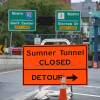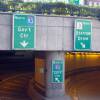At the Government Center T station on Wednesday morning, the fare-free Blue Line was periodically full of travelers wheeling their luggage onto the subway before catching an airport shuttle to their terminal at Logan Airport.
It’s the first day of the planned two-month closure of Sumner Tunnel, the mile-long connection between East Boston and downtown. Officials say the deteriorating 100-year-old tunnel is in need of an overhaul. They have urged travelers to plan ahead if they are heading to Logan between now and the end of August, and to use public transit, like the Blue Line, when possible.
Most passengers seemed to be taking the tunnel closure in stride as of Wednesday, like Lauren Woodward, who had budgeted an extra 50 minutes to get from her North End home in Boston to the airport via public transportation for a trip to North Carolina.
She said she understands that the Sumner Tunnel needed attention.
“Because driving through, it's pretty scary,” Woodward said, "When you drive through, it just looks so old and the ceilings and the tiles, and so I'm sure it's way overdue.”
Vincent Chen of Cambridge flew in from Washington D.C. on Wednesday, and was anticipating a delay getting home from the airport via a ride share.
"Usually it's not the easiest to get in and out of Logan,” Chen said. “And we've been following the updates on the closures, and we're hoping that it's not going to be too bad, but we're preparing for the worst.”
Chen said he expected his trip home to double to as much as 40 minutes.
Allan Johns was headed home to the Back Bay from Logan and was planning to take a shuttle bus, rather than his usual cab. He had expected that the wait for the bus and total trip to take almost an hour in total, rather than the usual 20 minute drive.
“The tunnels have been shut down, like, every weekend for a while now, so we've dealt with it one way or another,” said Johns. “I mean, infrastructure is always getting fixed one way or another. It is what it is.”
Several Uber passengers told GBH News that they weren’t seeing extremely long estimates for arrivals to various Greater Boston destinations.
⚠️The #SumnerTunnel is now CLOSED from July 5, 2023 until August 31, 2023. ⚠️ #DitchTheDrive and utilize public transportation:
— Mass. Transportation (@MassDOT) July 5, 2023
🚇 Free trips on the @MBTA Blue Line
⛴️ Free and discounted ferry options
🚆 Reduced @MBTA_CR fares & parking costs
ℹ️ https://t.co/EZdZn7URNH pic.twitter.com/tBQHHeYyKA
Massport officials had directed airlines to increase communication to passengers about alternatives when arriving at Logan. They also promised that there would be an increase in digital signage throughout all the terminals and baggage claim, and that more customer service staff would be present to answer questions.
But, many travelers waiting for ride shares Wednesday morning — both locals returning home, and those from other states — told GBH News that they didn’t notice increased signage or advice that notified them of the Sumner Tunnel closure, and how that might affect their ability to get from the airport to other destinations.
Rideshare drivers had mixed reactions about the impact of the closure for them. One Uber driver said he was anticipating a good day, income-wise, since he thought more circuitous and longer trips would garner higher fares.
But Uber driver Chris Edge disagreed.
“It's the same price for a passenger,” Edge said. “It's the same price for the driver, too. But, because of us sitting there waiting, we could have dropped that passenger off and went and got another passenger, and another passenger, and another passenger with the time that we waited in traffic.”
Officials are encouraging travelers to set aside much more time than usual, up to two hours, if heading to Logan this summer. The MBTA’s Blue Line and East Boston ferry will be free during the closure. Travelers can also get discounted tickets on the Logan Express bus. After the closure, officials say the Sumner Tunnel will still close on weekends over the fall and winter, and likely close again fully next summer.
GBH News' Bob Seay contributed to this report.









